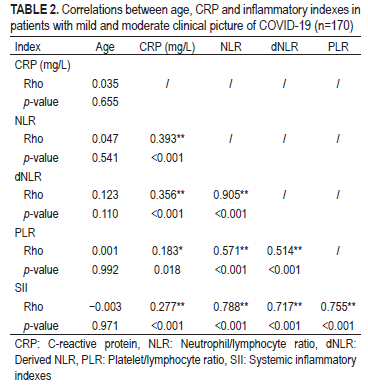Systemic inflammatory indexes (NLR, DNLR, PLR and SII) role in predicting COVID-19 progression
DOI:
https://doi.org/10.17532/jhsci.2023.2155Keywords:
systemic inflammatory indexes, coronavirus disease 2019, clinical pictureAbstract
Introduction: The coronavirus disease 2019 (COVID-19) pandemic has caused a worldwide emergency. The disease is characterized primarily by symptoms of the respiratory system, but also by systemic inflammation. Since the onset of the disease, there has been a need for biomarkers to predict the severity of the clinical picture and the outcome of the disease. The aim of this study is to evaluate systemic inflammatory markers for predicting severity of COVID-19.
Methods: The study was conducted at the Sarajevo Canton Health Center on a total of 170 adults suffering from COVID-19. 70 subjects had mild clinical picture, while the control group consisted of 100 subjects with moderate clinical picture. The results of complete and differential blood counts, C-reactive protein (CRP), and systemic inflammatory indexes (SII) (neutrophil/lymphocyte ratio [NLR], derived NLR [dNLR], platelet/lymphocyte ratio [PLR], and SII) were used to compare the groups. IBM SPSS Ver. 23 was used for statistical analysis and data processing.
Results: The proportion of male patients in the group with a milder clinical picture was higher than the proportion of male patients with a moderate clinical picture, p = 0.016. The values of leukocytes and neutrophils were higher in patients with a moderate clinical picture (p = 0.006 and p < 0.001, respectively). The values of all inflammatory indexes (NLR, dNLR, PLR and SII) were higher in patients with a moderate clinical picture of COVID-19 than in patients with a mild clinical picture (p < 0.001 for NLR, dNLR, and SII; p = 0.023 for PLR). In the research, patient age showed no correlation and CRP showed no correlation with SII.
Conclusion: SII show higher values in patients with a moderate compared with a mild clinical picture of COVID-19. These parameters can be cost-effective and useful indicators in patient classification, diagnosis, and probably in monitoring patients with COVID-19.
Downloads

Downloads
Published
License
Copyright (c) 2023 Berina Hasanefendić, Emir Šeherčehajić, Armina Dedić, Suzana Tihić-Kapidžić, Ermin Begović, Sanela Hajro, Belma Gazibera, Ahmed Velić, Melina Drljo

This work is licensed under a Creative Commons Attribution 4.0 International License.










